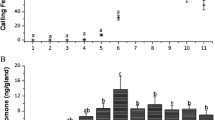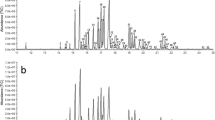Abstract
Chemical communication between adults of the American warble fly, Dermatobia hominis (Diptera: Oestridae), was investigated by electroantennography and behavioral bioassays. Significant electroantennographic responses were recorded from both sexes to hexane-soluble cuticular lipids from either sex. Olfactometer tests indicated an attraction between males and females, and between females. Copulatory behavior of males with a white knotted string treated with female extract confirmed production of a sexual stimulant by females. Such behavior was not observed in tests with male extract, demonstrating that the pheromone acts also as a sex recognition factor. Cuticular hydrocarbons of sexually mature female and male D. hominis were identified by Gas chromatography–mass spectrometry and consist of a mixture of saturated n-, monomethyl-, and dimethylalkanes in both sexes. Sexual dimorphism was characterized by a higher relative concentration of dimethylalkanes in males and the presence of alkenes only in females.





Similar content being viewed by others
References
Anderson, J. R., Nilssen, A. C., and Folstad, I. 1994. Mating behavior and thermoregulation of the reindeer warble fly, Hypoderma tarandi L. (Diptera: Oestridae). J. Insect. Behav. 7:679–706.
Banegas, A. D., and Mourier, H. 1967. Laboratory observations on the life-history and habits of Dermatobia hominis (Diptera, Cuterebridae). I. Mating behavior. Ann. Entomol. Soc. Am. 60:878–881.
Barbosa, C. G., Sanavria, A., Passos, M. D., and Barbosa, R. C. 2000. Período pupal da Dermatobia hominis (Diptera: Cuterebridae) em condições de temperatura ambiente. Parasitol. Dia 24:63–66.
Bolton, H. T., Butler, J. F., and Carlson, D. A. 1980. A mating stimulant pheromone of the horn fly, Haematobia irritans (L.): demonstration of biological activity in separated cuticular components. J. Chem. Ecol. 6:951–964.
Carlson, D. A., and Beroza, M. 1973. Field evaluation of (Z)-9-tricosene, a sex attractant pheromone of the house fly. Environ. Entomol. 2:555–559.
Carlson, D. A., and Schlein, Y. 1991. Unusual polymethyl alkenes in tsetse flies acting as abstinon in Glossina morsitans. J. Chem. Ecol. 17:267–284.
Carlson, D. A., Doolittle, R. E., Beroza, M., Rogoff, W. W., and Gretz, G. 1974. Muscalure and related compounds. I. Response of house flies in olfactometer and pseudofly Petri dish tests. J. Agric. Food Chem. 22:194–197.
Carlson, D. A., Offor, I. I., El Messoussi, S., Matsuyama, K., Mori, K., and Jallon, J. M. 1998. Sex pheromone of Glossina tachinoides: isolation, identification and synthesis. J. Chem. Ecol. 24:1563–1574.
Carlson, D. A., Geden, C. J., and Bernier, U. R. 1999. Identification of pupal exuviae of Nasonia vitripennis and Muscidifurax raptorellus parasitoids using cuticular hydrocarbons. Biol. Control 15:97–106.
Carlson, D. A., Berkebile, D. R., Skoda, S. R., Mori, K., and Mihok, S. 2007. Candidate sex pheromones of the New World screwworm Cochliomyia hominivorax. Med. Vet. Entomol. 21:93–96.
Catts, E. P., Garcia, R., and Poorbaugh, J. H. 1965. Aggregation sites of males of the common cattle grub, Hypoderma lineatum (De Villers) (Diptera: Oestridae). J. Med. Entomol. 1:357–358.
Chaudhury, M. F. B., Ball, H. J., and Jones, C. M. 1972. A sex pheromone of the female face fly, Musca autumnalis, and its role in sexual behavior. Ann. Entomol. Soc. Am. 65:607–612.
Eiras, A. E. 2001. Mediadores químicos entre hospedeiros e insetos vetores de doenças médico-veterinárias, pp. 99–112, in E. F. Vilela, and T. M. C. Della-Lucia (eds.). Feromônios de Insetos. Biologia, Química e Emprego no Manejo de PragasEditora Holos, Ribeirão Preto, SP, Brazil.
Fletcher, L. W., O’Grady, J. J. Jr., Claborn, H. V., and Graham, O. H. 1966. A pheromone from male screw-worm flies. J. Chem. Ecol. 59:142–143.
Francis, G. W., and Veland, K. 1981. Alkylthiolation for the determination of double-bond positions in linear alkenes. J. Chromatogr. 219:379–384.
Geier, M., and Boeckh, J. 1999. A new Y-tube olfactometer for mosquitoes to measure the attractiveness of host odors. Entomol. Exp. Appl. 92:9–19.
Grisi, L., Massard, C. L., Moya Borja, G. E., and Pereira, J. B. 2002. Impacto econômico das principais ectoparasitoses em bovinos no Brasil. Hora Vet 21:8–10.
Guimarães, J. H. 1966. Nota sobre os hábitos dos machos de Dermatobia hominis (Linnaeus Jr.) (Diptera: Cuterebridae). Papéis Avulsos Depto Zool. Sec. Agric. SP. 18:277–279.
Guimarães, J. H., and Papavero, N. 1999. Myiasis caused by obligatory parasites. VI. Dermatobia hominis (Linnaeus Jr.) (Cuterebridae), pp. 257–302, in J. H. Guimarães, and N. Papavero (eds.). Myiasis in Man and Animals in the Neotropical RegionEd Plêiade, São Paulo, SP, Brazil.
Hall, M., and Wall, R. 1995. Myiasis of humans and domestic animals. Adv. Parasitol. 35:258–334.
Howard, R. W., and Blomquist, G. J. 1982. Chemical ecology and biochemistry of insect hydrocarbons. Annu. Rev. Entomol. 27:149–172.
Krafsur, E. S. 1978. Aggregations of male screwworm flies, Cochliomyia hominivorax (Coquerel) in south Texas (Diptera: Calliphoridae). Proc. Entomol. Soc. Wash 80:164–170.
Lockey, K. H. 1980. Insect cuticular hydrocarbons. Comp. Biochem. Physiol. 65B:457–462.
Mehren, J. E. 2007. Mate recognition: should fly stay or should fly go? Curr. Biol. 17:240–242.
Millar, J. G., and Sims, J. J. 1998. Preparation, cleanup, and preliminary fractionation of extracts, p. 1, –, 37, in J.G. Millar, and K. F. Haynes (eds.). Methods in Chemical Ecology. Chemical Methods, vol. 1Kluwer, Norwell, MA.
Murvosh, C. M., Labrecque, G. C., and Smith, C. N. 1965. Sex attraction in the house fly, Musca domestica L. Ohio J. Sci. 65:68.
Nelson, D. R., Sukkestad, D. R., and Zaylskie, R. G. 1972. Mass spectra of methyl-branched hydrocarbons from eggs of the tobacco hornworm. J. Lipid Res. 13:413–421.
Nelson, D. R., Dillwith, J. W., and Blomquist, G. J. 1981. Cuticular hydrocarbons of the house fly, Musca domestica. Insect Biochem. 11:187–197.
Oliveira, G. P., Matsumoto, T., and Oliveira, M. C. S. (eds). 1999. Importância econômica e controle do berne (Dermatobia hominis, Diptera: Cuterebridae) na região de São Carlos, SP. Embrapa Pecuária do Sudeste. Technical Bulletin no. 22.
Pomonis, J. G. 1989. Cuticular hydrocarbons of the screwworm, Cochliomyia hominivorax (Diptera: Calliphoridae). Isolation, identification and quantification as a function of age, sex and irradiation. J. Chem. Ecol. 15:2301–2317.
Siegel, S., and Castellan, N. J. 1988. Nonparametric Statistics for the Behavioral Sciences. McGraw-Hill International Editions, New York, NY.
Sonnet, P. E., Uebel, E. C., Lusby, W. R., Schwarz, M., and Miller, R. W. 1979. Sex pheromone of the stable fly: identification, synthesis and evaluation of alkenes from female stable flies. J. Chem. Ecol 5:353–361.
Symonds, M. R. E., and Wertheim, B. 2005. The mode of evolution of aggregation pheromones in Drosophila species. J. Evol. Biol. 18:1253–1263.
Trabalon, M., Campan, M., Clement, J. L., Lange, C., and Miquel, M. T. 1992. Cuticular hydrocarbons of Calliphora vomitoria (Diptera: Calliphoridae): relation to age and sex. Gen. Comp. Endocrinol. 85:208–216.
Uebel, E. C., Menzer, R. E., Sonnet, P. E., and Miller, R. W. 1975a. Identification of the copulatory sex pheromone of the little house fly, Fannia canicularis (L.) (Diptera: Muscidae). N. Y. Entomol. Soc. 83:258–259.
Uebel, E. C., Sonnet, P. E., Bierl, B. A., and Miller, R. W. 1975b. Sex pheromone of the stable fly: isolation and preliminary identification of compounds that induce mating strike behavior. J. Chem. Ecol. 1:377–385.
Uebel, E. C., Schwarz, M., Lusby, W. R., Miller, R. W., and Sonnet, P. E. 1978a. Cuticular non-hydrocarbons of the female housefly and their evaluation as mating stimulants. Lloydia 41:63–67.
Uebel, E. C., Schwarz, M., Menzer, R. E., and Miller, R. W. 1978b. Mating-stimulant pheromone and cuticular lipid constituents of Fannia pusio (L.). J. Chem. Ecol. 4:73–81.
Wyatt, T. D. 2003. Pheromones and Animal Behavior. Communication by Smell and Taste. Cambridge University Press, Cambridge, UK.
Zar, J. H. 1999. Biostatistical Analysis. Prentice-Hall, Upper Saddle River, NJ, USA.
Acknowledgment
We thank Célia M. Sá for invaluable technical help with chromatography and Gabriela R. Chaves for indispensable assistance in collecting D. hominis larvae. We are also grateful to Steven J. Seybold and reviewers for their comments on the manuscript. This work is part of a Ph.D. thesis and was supported by CAPES fellowship to C.C.G.G., and FAPESP grant 98/01065-7 and CNPq fellowship to J.R.T.
Author information
Authors and Affiliations
Corresponding author
Rights and permissions
About this article
Cite this article
Gulias Gomes, C.C., Trigo, J.R. & Eiras, Á.E. Sex Pheromone of the American Warble Fly, Dermatobia hominis: The Role of Cuticular Hydrocarbons. J Chem Ecol 34, 636–646 (2008). https://doi.org/10.1007/s10886-008-9473-8
Received:
Revised:
Accepted:
Published:
Issue Date:
DOI: https://doi.org/10.1007/s10886-008-9473-8




